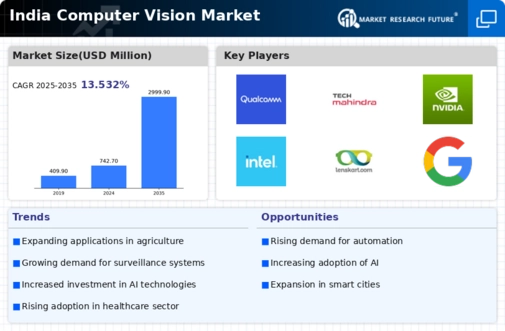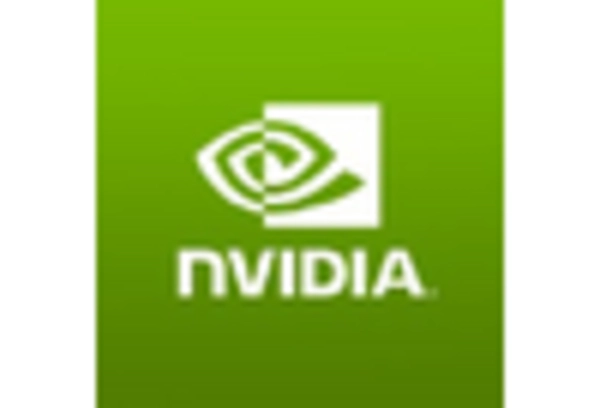Rising Demand for Automation
The computer vision market in India is experiencing a notable surge in demand for automation across various sectors. Industries such as manufacturing and logistics are increasingly adopting computer vision technologies to enhance operational efficiency and reduce human error. This trend is driven by the need for real-time monitoring and quality control, which computer vision systems can provide. According to recent estimates, the automation market in India is projected to grow at a CAGR of approximately 20% over the next five years. This growth is likely to propel the computer vision market, as companies seek to integrate advanced technologies to streamline processes and improve productivity. As automation becomes a critical component of business strategy, the computer vision market is expected to play a pivotal role in facilitating this transition.
Government Initiatives and Support
Government initiatives aimed at promoting technology adoption are playing a crucial role in the growth of the computer vision market in India. Programs such as 'Digital India' and 'Make in India' are encouraging businesses to invest in advanced technologies, including computer vision. These initiatives are designed to enhance the country's technological infrastructure and foster innovation. Furthermore, the government is providing financial incentives and support for startups focusing on computer vision applications. This supportive environment is expected to stimulate market growth, as more companies are likely to explore and implement computer vision solutions. The computer vision market is thus positioned to benefit from these favorable policies, which aim to boost the overall technology landscape in India.
Increasing Investment in Smart Cities
The push towards developing smart cities in India is significantly impacting the computer vision market. As urbanization accelerates, there is a growing need for intelligent systems that can manage city infrastructure efficiently. Computer vision technologies are being deployed for traffic management, public safety, and urban planning. The Indian government has allocated substantial funds for smart city projects, with an estimated investment of $1.2 billion in the current fiscal year. This investment is likely to create numerous opportunities for computer vision applications, as cities seek to leverage technology to improve the quality of life for residents. The computer vision market is thus poised to thrive in this context, driven by the demand for innovative solutions in urban environments.
Surge in E-commerce and Online Retail
The rapid growth of e-commerce and online retail in India is creating new avenues for the computer vision market. Retailers are increasingly utilizing computer vision technologies for inventory management, customer behavior analysis, and personalized shopping experiences. The e-commerce sector in India is projected to reach $200 billion by 2026, indicating a robust market for computer vision applications. As businesses strive to enhance customer engagement and streamline operations, the demand for computer vision solutions is expected to rise. This trend suggests that the computer vision market will continue to expand, driven by the evolving needs of the retail sector and the increasing reliance on technology to meet consumer expectations.
Advancements in AI and Machine Learning
The integration of artificial intelligence (AI) and machine learning (ML) into computer vision systems is significantly influencing the market in India. These advancements enable more sophisticated image processing and analysis, allowing for improved accuracy and efficiency in various applications. For instance, sectors such as agriculture and security are leveraging AI-driven computer vision solutions to enhance crop monitoring and surveillance systems. The Indian AI market is anticipated to reach $7.8 billion by 2025, which suggests a strong correlation with the growth of the computer vision market. As organizations increasingly recognize the potential of AI and ML, the demand for innovative computer vision applications is likely to escalate, further driving market expansion.

















Leave a Comment